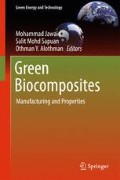Abstract
Manufacturing plays a vital role in the development of a country. At present the trend of industrialists is turned to green sustainable manufacturing which focuses on reduce, reuse and recycle concept for preparation of materials, products. On the other side petroleum based products are finite, create environmental problems and deplete in specific time period. So, the mankind on this earth has to definitely rely on renewable energy sources and sustainable inexhaustible materials. In the present investigation a novel “Manual Compression Molding” (MCM) technique is introduced to prepare the composites using Polylactic Acid (PLA) and sugarcane bagasse particulate (SBP). Prior to the manufacturing of composites sugarcane bagasse particulate is synthesized using mechanical mixer and is analyzed for its size, morphology. Initially PLA lamina is prepared at different contents and is mechanically characterized to understand the ability of MCM method. Further the composites prepared by compounding and MCM are tested under mechanical loading and the results are compared with the composites made by MCM alone. As a whole MCM technique is successfully employed for making composites. In case of plain PLA, composition P1, P5 have given highest tensile strength, modulus of 11.41 MPa, 0.54 GPa respectively. However, at R1 reinforcement in PLA tensile strength is enhanced by 11 % when compared with PLA. Similar kind of nature is possessed by PLA-SBP composites at R1 whose flexural strength, modulus is 38.43 MPa, 2.71 GPa respectively under bending load. But compounding (C) results in good mixing of reinforcement with the matrix and further MCM method had given flexural strength, modulus of 37.04 MPa, 3.5 GPa respectively. In analyzing PLA-SBP composites C composition has shown 1.84 kJ/m2 Charpy impact strength. Finally the composites are examined under Scanning Electron Microscope to know the bond between reinforcement and matrix.
Access this chapter
Tax calculation will be finalised at checkout
Purchases are for personal use only
References
Acharya SK, Mishra P, Mehar SK, Dikshit V (2008) Weathering behavior of bagasse fiber reinforced polymer composite. J Reinf Plast Compos 27:1839–1846
Arrakhiz FZ, Malha M, Bouhfid R, Benmoussa K, Qaiss A (2013) Tensile, flexural and torsional properties of chemically treated alfa, coir and bagasse reinforced polypropylene. Compos: Part B 47:35–41
Burr GO, Hartt CE, Brodie HW, Tanimoto T, Kortschak HP, Takahashi D, Ashton FM, Colemman RE (1957) The sugarcane plant. Ann Rev Plant Physiol 8:275–308
Cao Y, Shibata S, Fukumoto I (2006) Mechanical properties of biodegradable composites reinforced with bagasse fibre before and after alkali treatments. Compos: Part A 37:423–429
de Sousa MV, Monteiro SN, d’Almeida JRM (2004) Evaluation of pre-treatment, size and molding pressure on flexural mechanical behavior of chopped bagasse–polyester composites. Polym Test 23:253–258
de Teixeira ED, Curvelo AA, Corrêa AC, Marconcini JM, Glenn GM, Mattoso LH (2012) Properties of thermoplastic starch from cassava bagasse and cassava starch and their blends with poly (lactic acid). Ind Crops Prod 37:61–68
Guimarãesa JL, Frollini E, da Silva CG, Wypychc F, Satyanarayana KG (2009) Characterization of banana, sugarcane bagasse and sponge gourd fibers of Brazil. Ind Crops Prod 30:407–415
Khalil HPSA, Bhat AH, Yusra AFI (2012) Green composites from sustainable cellulose nanofibrils: a review. Carbohydr Polym 87:963–979
Kiple KF, Ornelas KC (2000) The Cambridge world history of food, vol 1. Cambridge University Press, Cambridge, p 438
La Mantia FP, Morreale M (2011) Green composites: a brief review. Compos Part A 42:579–588
Luz SM, Gonçalves AR, Del’Arco AP Jr (2007) Mechanical behavior and microstructural analysis of sugarcane bagasse fibers reinforced polypropylene composites. Compos Part A 38:1455–1461
Luz SM, Del Tio J, Rocha GJ, Gonçalves AR, Jr Del’Arco AP (2008) Cellulose and cellulignin from sugarcane bagasse reinforced polypropylene composites: effect of acetylation on mechanical and thermal properties. Compos Part A 39:1362–1369
Monteiro SN, Rodriquez RJS, De Souza MV (1998) Sugar cane bagasse waste as reinforcement in low cost composites. Adv Perform Mater 5:183–191
Mulinari DR, Voorwald HJ, Cioffi MO, Da Silva ML, da Cruz TG, Saron C (2009) Sugarcane bagasse cellulose/HDPE composites obtained by extrusion. Compos Sci Technol 69:214–219
Paiva JMF, Frollini E (2002) Sugarcane bagasse reinforced phenolic and lignophenolic composites. J Appl Polym Sci 83:880–888
Saw SK, Datta C (2009) Thermomechanical properties of jute/bagasse hybrid fibre reinforced epoxy thermoset composites. BioResources 4:1455–1476
Vallejos ME, Curvelo AA, Teixeira EM, Mendes FM, Carvalho AJ, Felissia FE, Area MC (2011) Composite materials of thermoplastic starch and fibers from the ethanol–water fractionation of bagasse. Ind Crops Prod 33:739–746
Vilay V, Mariatti M, Taib RM, Todo M (2008) Effect of fiber surface treatment and fiber loading on the properties of bagasse fiber–reinforced unsaturated polyester composites. Compos Sci Technol 68:631–638
Xu Y, Wu Q, Lei Y, Yao F (2010) Creep behavior of bagasse fiber reinforced polymer composites. Bioresour Technol 101:3280–3286
Zini E, Scandola M (2011) Green composites: an overview. Polym Compos 32:1905–1915
Author information
Authors and Affiliations
Corresponding author
Editor information
Editors and Affiliations
Rights and permissions
Copyright information
© 2017 Springer International Publishing AG
About this chapter
Cite this chapter
Srinivasababu, N. (2017). Characterization Sugarcane Bagasse Particulate Reinforced Polylactic Acid Composites Prepared by Compounding and Manual Compression Molding Technique. In: Jawaid, M., Sapuan, S., Alothman, O. (eds) Green Biocomposites. Green Energy and Technology. Springer, Cham. https://doi.org/10.1007/978-3-319-46610-1_16
Download citation
DOI: https://doi.org/10.1007/978-3-319-46610-1_16
Published:
Publisher Name: Springer, Cham
Print ISBN: 978-3-319-46609-5
Online ISBN: 978-3-319-46610-1
eBook Packages: EnergyEnergy (R0)

